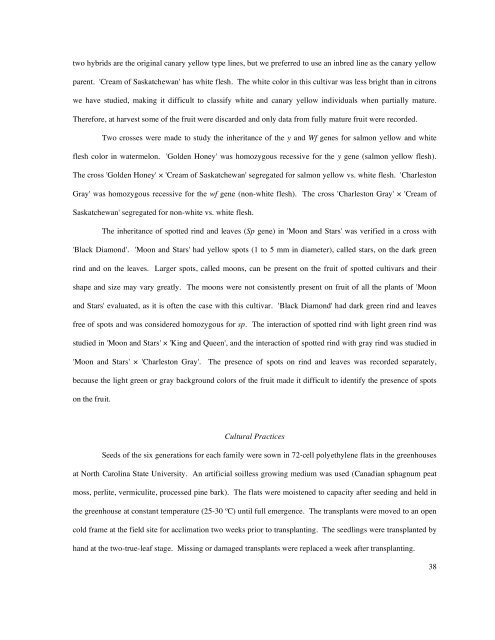Citrullus lanatus (Thunb.) Matsum. & Nakai - Cucurbit Breeding ...
Citrullus lanatus (Thunb.) Matsum. & Nakai - Cucurbit Breeding ...
Citrullus lanatus (Thunb.) Matsum. & Nakai - Cucurbit Breeding ...
Create successful ePaper yourself
Turn your PDF publications into a flip-book with our unique Google optimized e-Paper software.
two hybrids are the original canary yellow type lines, but we preferred to use an inbred line as the canary yellow<br />
parent. 'Cream of Saskatchewan' has white flesh. The white color in this cultivar was less bright than in citrons<br />
we have studied, making it difficult to classify white and canary yellow individuals when partially mature.<br />
Therefore, at harvest some of the fruit were discarded and only data from fully mature fruit were recorded.<br />
Two crosses were made to study the inheritance of the y and Wf genes for salmon yellow and white<br />
flesh color in watermelon. 'Golden Honey' was homozygous recessive for the y gene (salmon yellow flesh).<br />
The cross 'Golden Honey' × 'Cream of Saskatchewan' segregated for salmon yellow vs. white flesh. 'Charleston<br />
Gray' was homozygous recessive for the wf gene (non-white flesh). The cross 'Charleston Gray' × 'Cream of<br />
Saskatchewan' segregated for non-white vs. white flesh.<br />
The inheritance of spotted rind and leaves (Sp gene) in 'Moon and Stars' was verified in a cross with<br />
'Black Diamond'. 'Moon and Stars' had yellow spots (1 to 5 mm in diameter), called stars, on the dark green<br />
rind and on the leaves. Larger spots, called moons, can be present on the fruit of spotted cultivars and their<br />
shape and size may vary greatly. The moons were not consistently present on fruit of all the plants of 'Moon<br />
and Stars' evaluated, as it is often the case with this cultivar. 'Black Diamond' had dark green rind and leaves<br />
free of spots and was considered homozygous for sp. The interaction of spotted rind with light green rind was<br />
studied in 'Moon and Stars' × 'King and Queen', and the interaction of spotted rind with gray rind was studied in<br />
'Moon and Stars' × 'Charleston Gray'. The presence of spots on rind and leaves was recorded separately,<br />
because the light green or gray background colors of the fruit made it difficult to identify the presence of spots<br />
on the fruit.<br />
Cultural Practices<br />
Seeds of the six generations for each family were sown in 72-cell polyethylene flats in the greenhouses<br />
at North Carolina State University. An artificial soilless growing medium was used (Canadian sphagnum peat<br />
moss, perlite, vermiculite, processed pine bark). The flats were moistened to capacity after seeding and held in<br />
the greenhouse at constant temperature (25-30 ºC) until full emergence. The transplants were moved to an open<br />
cold frame at the field site for acclimation two weeks prior to transplanting. The seedlings were transplanted by<br />
hand at the two-true-leaf stage. Missing or damaged transplants were replaced a week after transplanting.<br />
38
















